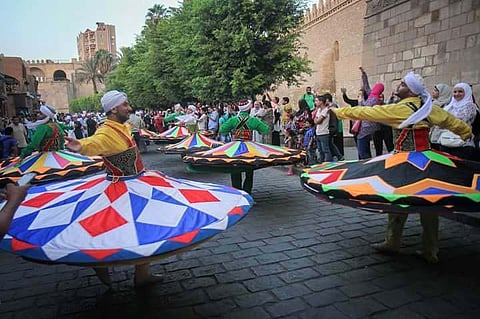Watch: Tanoura dancers find their feet in Egypt
Religious dance originally from Turkey has evolved and become popular with Egypt’s youth

Cairo: Wearing a multi-coloured skirt, Samir Ahmad started slowly whirling to the tune of a recorded religious music in the background.
Silence soon overwhelmed the audience — both old and young — who encircled the dance floor.
The performer looked rapt and oblivious of the surrounding as he span in a circular fashion with his moves steadily picking up pace.
He then agilely raised a circular colourful cloth from around the waist and circulated it above his head in breathtaking movements.
With the music reaching a crescendo, he silently stretched out his hands towards the sky as though praying.
Originally a circus acrobat, Ahmad made a career shift some years ago to the Tanoura performances, inspired by Sufis or mystics. Tanoura, literally “skirt” in Arabic, is widely popular at Sufi and non-Sufi festivals in mostly Muslim Egypt.
“Tanoura is as tough as performances at the circus. Both require high physical fitness and endurance,” said Ahmad.
It takes grueling exercise to be a good Tanoura dancer.
“The Tanoura dancer has to be physically fit and free of diseases especially the heart diseases and high blood pressure because he spins a lot while performing. He has to maintain balance and overcome any dizziness,” Ahmad explained.
“But Tanoura also purifies the soul and elevates the devoted performer to a new world away from life worries,” he told Gulf News.
It isn’t a show for earning money or admiration. The performer should leave worldly concerns behind him and give himself over completely to the dance. It is a kind of an expressive dance seeking forgiveness from Allah and spiritual sublimity. It makes the body and the soul one thingSamir Ahmad
“It isn’t a show for earning money or admiration. The performer should leave worldly concerns behind him and give himself over completely to the dance. It is a kind of an expressive dance seeking forgiveness from Allah and spiritual sublimity. It makes the body and the soul one thing.”
What are the origins of Tanoura dance?
Some historians say that the Tanoura dance came to Egypt in the 14th century from Turkey.
In the beginning, it was limited to the Sufi community.
Sufis were seen performing it while pointing the two hands simultaneously to the sky and the earth, in a sign of connection between them.
How has the dance evolved in Egypt?
But with the passage of time, it has become an Egyptian folk dance performed by non-Sufis, too.
The dance is performed at official ceremonies and wedding parties of different social classes.
Tanoura is also a staple show in entertainment programmes presented at most tourist resorts in Egypt.
“As the tourists come to Egypt to see the Pyramids and other famous monuments, they also come to enjoy Tanoura,” Ahmad said.
He also points to differences between the Egyptian-style Tanoura and the Turkish edition.
“In Turkey, the Tanoura dancer usually wears a flowing white gown topped by a vest with a long fez on the head. He moves slowly to the tempo of religious music and odes,” he said.
“But the Egyptian Tanoura dancer can perform while wearing a pair of trousers, a shoal and a skullcap. Moreover, the Egyptian dancer spins swiftly. He can also dance to the accompaniment of folksy music, which is one reason why the Tanoura is becoming popular with the youngsters. Egyptians have also introduced the use of such accessories as festive lanterns and tambourines during the performance, further lending the Egyptian touch to Tanoura.”
Shawqi Saeed, a Tanoura fan, agrees.
“Although I didn’t have the chance to practise the Tanoura due to health problems, I have been fascinated with it for years,” said Saeed, a 33-year-old father of two.
“In my opinion, it frees the soul from the shackles of the body and life pressure.”
Saeed, an engineer, said he is keen to take his family with him to attend Tanoura shows.
“I want them to enjoy it and know its spiritual and physical benefits. It’s good that the state authorities have shown interest in preserving it as part of our cultural heritage,” he said.
In the 1980s, Egypt launched a Tanoura troupe, who often performs at a bustling state-run cultural centre in medieval Cairo.
Sign up for the Daily Briefing
Get the latest news and updates straight to your inbox


